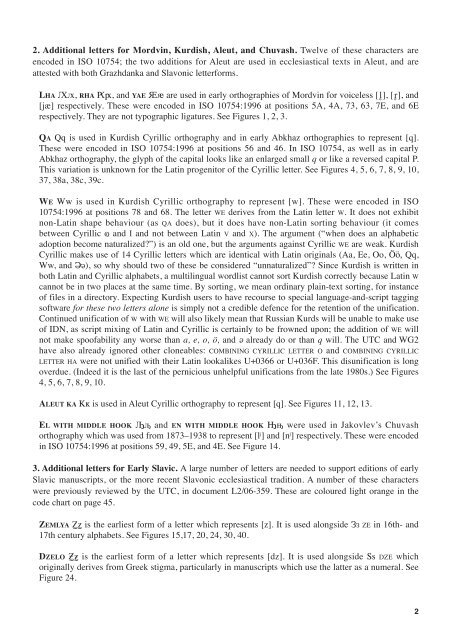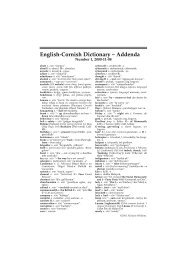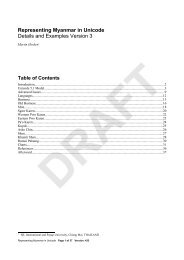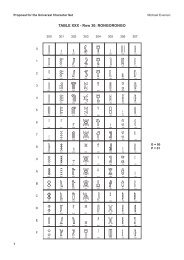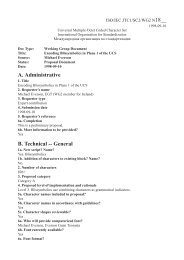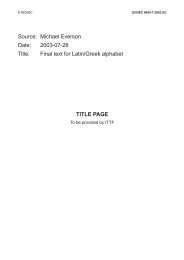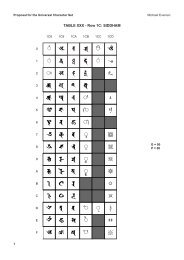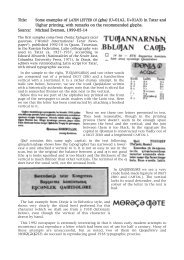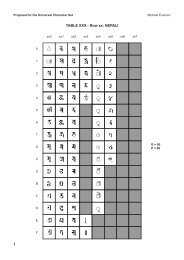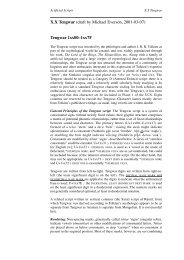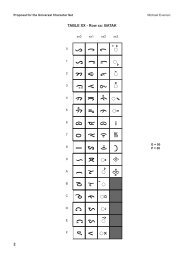ISO/IEC JTC1/SC2/WG2 N3194 L2/06-xxx - Evertype
ISO/IEC JTC1/SC2/WG2 N3194 L2/06-xxx - Evertype
ISO/IEC JTC1/SC2/WG2 N3194 L2/06-xxx - Evertype
Create successful ePaper yourself
Turn your PDF publications into a flip-book with our unique Google optimized e-Paper software.
2. Additional letters for Mordvin, Kurdish, Aleut, and Chuvash. Twelve of these characters are<br />
encoded in <strong>ISO</strong> 10754; the two additions for Aleut are used in ecclesiastical texts in Aleut, and are<br />
attested with both Grazhdanka and Slavonic letterforms.<br />
LHA îï, RHA ñó, and YAE òô are used in early orthographies of Mordvin for voiceless [l∞], [r∞], and<br />
[jæ] respectively. These were encoded in <strong>ISO</strong> 10754:1996 at positions 5A, 4A, 73, 63, 7E, and 6E<br />
respectively. They are not typographic ligatures. See Figures 1, 2, 3.<br />
QA öõ is used in Kurdish Cyrillic orthography and in early Abkhaz orthographies to represent [q].<br />
These were encoded in <strong>ISO</strong> 10754:1996 at positions 56 and 46. In <strong>ISO</strong> 10754, as well as in early<br />
Abkhaz orthography, the glyph of the capital looks like an enlarged small q or like a reversed capital P.<br />
This variation is unknown for the Latin progenitor of the Cyrillic letter. See Figures 4, 5, 6, 7, 8, 9, 10,<br />
37, 38a, 38c, 39c.<br />
WE úù is used in Kurdish Cyrillic orthography to represent [w]. These were encoded in <strong>ISO</strong><br />
10754:1996 at positions 78 and 68. The letter WE derives from the Latin letter W. It does not exhibit<br />
non-Latin shape behaviour (as QA does), but it does have non-Latin sorting behaviour (it comes<br />
between Cyrillic © and œ and not between Latin V and X). The argument (“when does an alphabetic<br />
adoption become naturalized?”) is an old one, but the arguments against Cyrillic WE are weak. Kurdish<br />
Cyrillic makes use of 14 Cyrillic letters which are identical with Latin originals (Aa, Ee, Oo, ÊÁ, Qq,<br />
Ww, and ÿŸ), so why should two of these be considered “unnaturalized”? Since Kurdish is written in<br />
both Latin and Cyrillic alphabets, a multilingual wordlist cannot sort Kurdish correctly because Latin W<br />
cannot be in two places at the same time. By sorting, we mean ordinary plain-text sorting, for instance<br />
of files in a directory. Expecting Kurdish users to have recourse to special language-and-script tagging<br />
software for these two letters alone is simply not a credible defence for the retention of the unification.<br />
Continued unification of W with WE will also likely mean that Russian Kurds will be unable to make use<br />
of IDN, as script mixing of Latin and Cyrillic is certainly to be frowned upon; the addition of WE will<br />
not make spoofability any worse than a, e, o, ö, and Ÿ already do or than q will. The UTC and <strong>WG2</strong><br />
have also already ignored other cloneables: COMBINING CYRILLIC LETTER O and COMBINING CYRILLIC<br />
LETTER HA were not unified with their Latin lookalikes U+0366 or U+036F. This disunification is long<br />
overdue. (Indeed it is the last of the pernicious unhelpful unifications from the late 1980s.) See Figures<br />
4, 5, 6, 7, 8, 9, 10.<br />
ALEUT KA ûü is used in Aleut Cyrillic orthography to represent [q]. See Figures 11, 12, 13.<br />
EL WITH MIDDLE HOOK †° and EN WITH MIDDLE HOOK ¢£ were used in Jakovlev’s Chuvash<br />
orthography which was used from 1873–1938 to represent [l j ] and [n j ] respectively. These were encoded<br />
in <strong>ISO</strong> 10754:1996 at positions 59, 49, 5E, and 4E. See Figure 14.<br />
3. Additional letters for Early Slavic. A large number of letters are needed to support editions of early<br />
Slavic manuscripts, or the more recent Slavonic ecclesiastical tradition. A number of these characters<br />
were previously reviewed by the UTC, in document <strong>L2</strong>/<strong>06</strong>-359. These are coloured light orange in the<br />
code chart on page 45.<br />
ZEMLYA ÄÅ is the earliest form of a letter which represents [z]. It is used alongside ó∑ ZE in 16th- and<br />
17th century alphabets. See Figures 15,17, 20, 24, 30, 40.<br />
DZELO ÇÉ is the earliest form of a letter which represents [dz]. It is used alongside Ö’ DZE which<br />
originally derives from Greek stigma, particularly in manuscripts which use the latter as a numeral. See<br />
Figure 24.<br />
2


